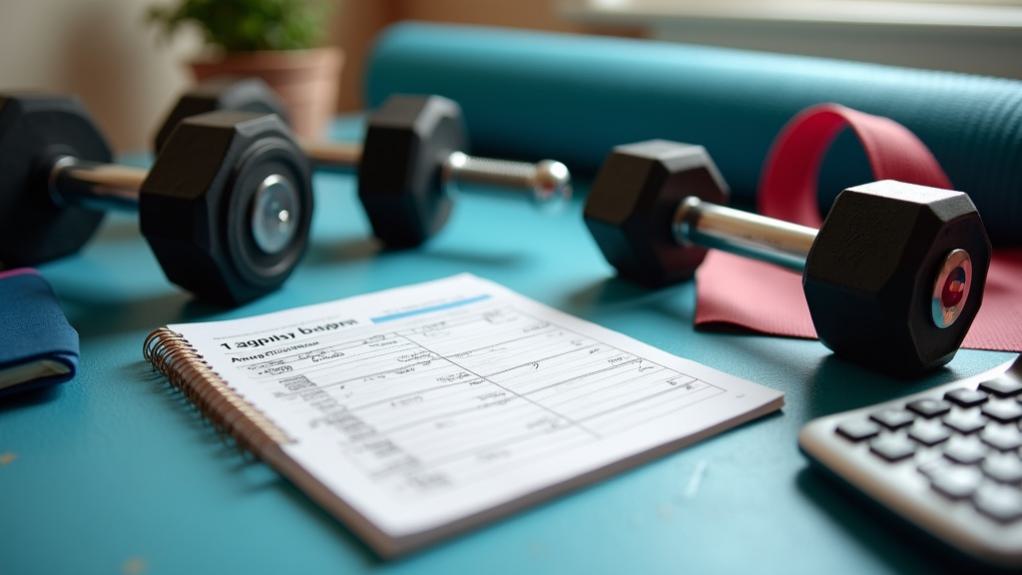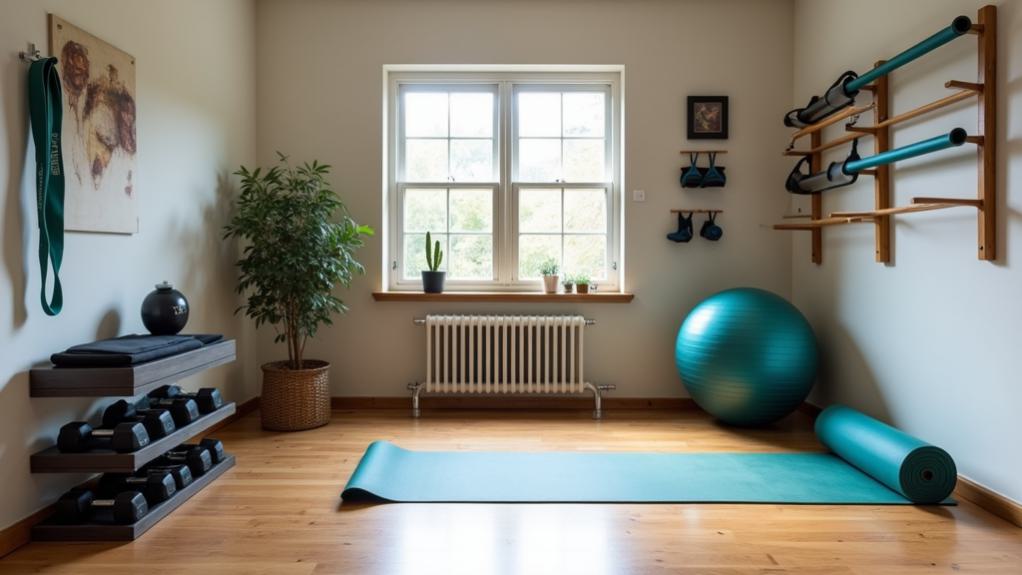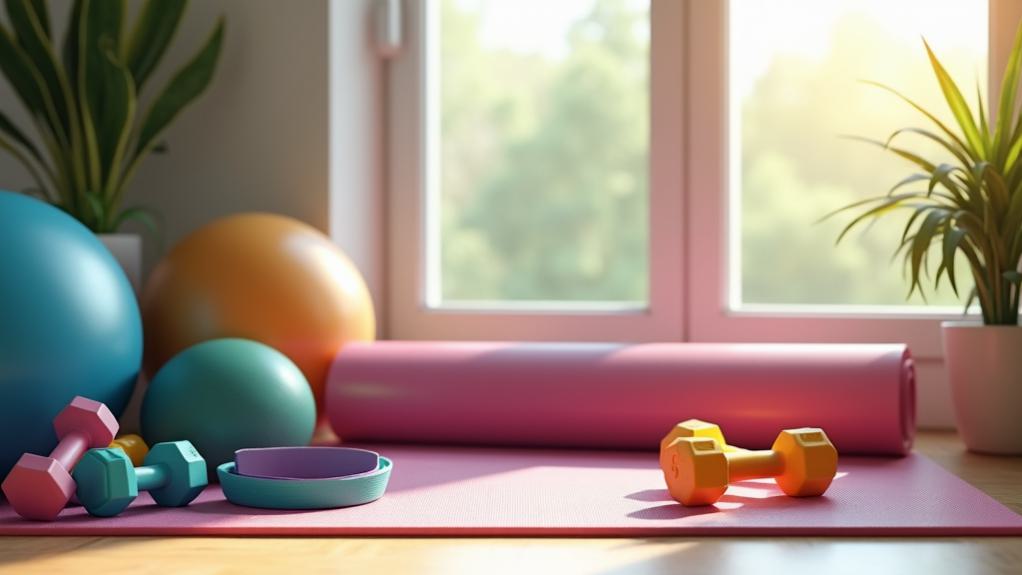Choosing the right fitness equipment for your home workouts starts with evaluating your space and defining your fitness goals. Measure your workout area to guarantee equipment fits without overcrowding. Set a budget that reflects both your needs and financial comfort, prioritizing essential items like dumbbells or resistance bands. Consider equipment that aligns with your specific objectives, whether it’s for weight loss or muscle building. Don’t forget to check reviews for quality and safety. A well-thought-out selection maximizes your workout potential. Stick around, and you’ll discover even more tips to enhance your home fitness journey.
Key Takeaways
- Assess your space to ensure equipment fits and allows for safe movement without clutter or distractions.
- Set a budget that accounts for initial costs, maintenance, and potential savings from canceling gym memberships.
- Define specific fitness goals to guide equipment selection, aligning purchases with your aspirations.
- Research quality equipment options with good consumer ratings, prioritizing safety and multi-functional use.
- Commit to regular maintenance and hygiene practices to prolong equipment life and ensure safe usage.
Benefits of Home Workouts
Embracing home workouts offers numerous benefits that can transform your fitness journey. One of the standout advantages is the convenience they provide. You can seamlessly integrate exercise into your daily routine without the hassle of traveling to a gym. This flexibility often leads to higher consistency, vital for achieving your fitness goals.
Moreover, engaging in home workouts helps create a comfortable environment where you can focus on your exercise options without feeling self-conscious. This privacy boosts your self-esteem and mood while allowing you to enjoy your workouts.
You’ll find that regular physical activity at home not only promotes cardiovascular health but aids in long-term weight management by increasing calorie expenditure.
Additionally, home workouts empower you to tailor your routines to meet your specific fitness goals. You can choose the right workout equipment based on your preferences and needs, enhancing both motivation and enjoyment.
The benefits of home workouts are clear—improved physical health, heightened self-confidence, and a personalized approach to fitness. By embracing this method, you’re setting yourself up for lasting success on your health journey.
Assessing Your Space
Before diving into home workouts, it’s crucial to assess your workout space effectively. Knowing your available space will help you choose the right fitness equipment and create an efficient gym space.
Start by measuring the total square footage, ensuring it accommodates both your equipment and the necessary movement area.
- Confirm ceiling height for overhead exercises, especially if you plan to use taller equipment like a power rack or pull-up bar.
- Plan the layout carefully to avoid overcrowding, which can lead to safety hazards and limit your exercise variety.
- Identify distractions, such as noise or foot traffic, that could disrupt your focus during workouts.
Setting a Budget

Setting a budget for your home workout equipment is vital to ensuring you make smart investments.
Start by defining a budget range that includes both initial costs and long-term needs, prioritizing essential items first.
Don’t forget to explore affordable options, like used or refurbished gear, to maximize your fitness potential without breaking the bank.
Define Budget Range
Creating a budget for your home workout equipment is essential to guarantee you make informed purchases that align with your financial situation. Establish a clear budget range based on your personal financial capacity. Remember, home gym equipment can vary widely—basic items may cost as low as $50, while advanced machines can exceed $2,000.
Start by focusing on essential equipment like:
- Dumbbells: Often starting at around $20.
- Resistance Bands: Affordable and versatile options for strength training.
- Yoga Mats: Perfect for stretching and core workouts, usually around $30.
Consider potential long-term savings from cancelling gym memberships, which average $40 monthly. That’s over $480 annually, helping offset your equipment costs.
Additionally, research affordable options available through major retailers or online platforms. These often provide discounts or financing plans to make quality equipment accessible within your budget.
Don’t forget to factor in maintenance costs for larger purchases—like treadmills or ellipticals—which can range from $50 to $150 annually. This will guarantee your home gym remains safe and effective for years to come.
Prioritize Essential Equipment
When building a home gym, prioritizing essential equipment is crucial for maximizing your investment and achieving your fitness goals. Start by establishing a clear budget range, which will guide your purchasing decisions and help you avoid overspending.
Focus on basic equipment like dumbbells or resistance bands; these options are often affordable and versatile, enabling you to perform a wide variety of exercises.
Consider space-efficient items, like adjustable benches or foldable equipment, to help you make the most of your workout area while staying within your budget. Research consumer ratings and reviews to identify high-quality equipment that meets your fitness needs without breaking the bank.
Plan your purchases strategically, focusing on essential equipment first. As you consistently use your gym and your fitness goals evolve, you can gradually expand your collection.
This method guarantees that you invest wisely and create a functional workout space that adapts to your changing needs. By prioritizing essential equipment, you’ll set yourself up for long-term success in your home fitness journey, making each dollar spent count towards your overall health and well-being.
Explore Affordable Options
With a solid foundation of essential equipment in place, it’s time to explore how to make your home workout setup financially feasible. Establishing a clear budget is vital.
Take into account both the initial costs and the long-term savings from skipping gym memberships. Start with affordable options like:
- Dumbbells for strength training
- Resistance bands for versatile exercise
- An exercise mat for comfort
You can often find these essential items at major retailers for under $100 combined.
Don’t overlook used equipment or budget-friendly brands that still offer quality; many options maximize your investment without sacrificing functionality.
Another tip is to think about multi-functional equipment. Adjustable dumbbells or resistance bands with varying resistance levels can replace multiple items, saving both space and money.
When setting your budget, also keep in mind additional costs such as maintenance and warranties to guarantee your equipment remains reliable for years to come.
Defining Fitness Goals
Defining your fitness goals is the cornerstone of an effective home workout regimen. When you clearly articulate your objectives—whether it’s weight loss, building muscle, or improving cardiovascular health—you’re setting a solid foundation for your fitness journey.
Research shows that 60% of individuals with specific goals are more likely to achieve them compared to those without defined targets.
If weight loss is your aim, consider exercise equipment like treadmills or stationary bikes. These tools are perfect for high-calorie-burning cardio workouts that help you shed those extra pounds.
On the other hand, if building muscle is your priority, investing in dumbbells, resistance bands, and a bench will enable you to perform a variety of strength training exercises essential for hypertrophy.
A well-defined fitness goal not only shapes your workout plan but also helps you prioritize your investments in equipment. By aligning your purchases with your personal aspirations, you can avoid unnecessary spending on items that don’t meet your needs.
Evaluating Equipment Options

When evaluating your equipment options, start by reviewing your workout space to guarantee everything fits comfortably.
Next, define your budget to prioritize essential pieces that align with your fitness goals.
Assess Your Space
Creating an effective home workout space requires careful consideration of your environment. To start, you need to assess your space. Measure the dimensions of your workout area to guarantee the equipment you choose fits comfortably without overcrowding. This allows for safe movement during exercises and helps prevent injuries.
Consider these key aspects:
- Ceiling height: Essential for overhead movements to avoid accidents.
- Flooring type: Rubber mats are excellent for impact absorption and stability.
- Obstacles: Identify distractions like furniture or heavy traffic that could interfere with your focus.
If you’re working with limited space, opt for versatile equipment that can easily be stored or adjusted. This flexibility allows for varied workouts as your fitness needs evolve.
By planning correctly, you can create a space that not only accommodates your current equipment but also supports your fitness journey in the long term. Remember, a well-assessed space minimizes potential hazards and maximizes your workout efficiency.
Define Your Budget
Establishing a budget for your home workout equipment is essential to guarantee you get the most value for your investment. Start by determining a realistic budget range that considers both initial costs and any potential long-term expenses.
Research average prices for essential equipment like dumbbells, which typically range from $1 to $2 per pound, and resistance bands that can cost between $10 and $50.
Think about the cost-effectiveness of multi-functional equipment. While these items may have a higher upfront price, they can replace several individual pieces and save you both space and money in the long run.
Don’t forget to factor in ongoing costs, such as replacement parts, maintenance supplies, and any subscription fees for online fitness programs or classes.
To stretch your budget further, keep an eye out for seasonal sales and discounts. You can also explore second-hand options, which often provide quality equipment at a fraction of the price.
Identify Fitness Goals
Your fitness goals are the compass guiding your equipment choices for home workouts. To select the right tools, start by defining your primary objectives—whether it’s weight loss, muscle gain, or improving cardiovascular health. Different equipment serves distinct purposes, so it’s essential to align your choices with your goals.
Consider these key aspects:
- Enjoyment: Choose exercises you love, ensuring long-term commitment.
- Versatility: Opt for equipment that supports various workout styles, like resistance bands or a weight bench.
- Current Fitness Level: Assess what you can handle; adjustable weights and low-impact machines cater to varying capabilities.
Research versatile options that can adapt to your exercise program, combining strength training and flexibility. For instance, resistance bands are fantastic for both toning muscles and enhancing mobility.
Maintenance and Care
Maintaining fitness equipment is essential for guaranteeing it operates smoothly and lasts as long as possible. Regular maintenance, such as lubricating moving parts on your treadmills and ellipticals, can greatly prolong their lifespan.
Make it a habit to inspect your equipment for wear and tear. Check cables and resistance bands for fraying to prevent accidents during your workouts.
Always follow the manufacturer’s guidelines for cleaning and care. Improper maintenance can’t only void warranties but also lead to costly repairs that could have been avoided.
Store your equipment in a dry, cool environment to prevent rust and corrosion, especially for metal components and resistance bands.
Additionally, consider scheduling periodic professional servicing for complex machines, like rowers and multi-station gyms. This guarantees peak performance and adherence to safety standards.
By investing time in proper care and maintenance, you’ll keep your fitness equipment in top shape, allowing you to focus on achieving your fitness goals without worrying about unexpected breakdowns or safety issues.
Taking these proactive steps will enhance your workout experience and guarantee your equipment serves you well for years to come.
Tips for Safe Usage

Using fitness equipment safely is fundamental for maximizing your workout while minimizing the risk of injury. To guarantee your safety during home workouts, follow these important tips:
- Inspect equipment regularly for wear and tear, checking for frayed cables or loose parts.
- Use proper form and technique to perform exercises effectively, lowering the chance of injury. If you’re unsure, consult a fitness professional for guidance.
- Maintain a clutter-free workout area to allow for safe movement and prevent tripping hazards.
Always adhere to the manufacturer’s instructions for setup and usage, as this is critical for preventing accidents and guaranteeing peak performance.
Additionally, commit to a consistent routine of cleaning and sanitizing your equipment. This not only promotes hygiene but also reduces the risk of illness while exercising.
By prioritizing safety and proper usage, you’ll create an environment that encourages effective workouts while safeguarding your health.
Conclusion
Choosing the right fitness equipment for home workouts can transform your routine, elevate your motivation, and enhance your results. By evaluating your space, setting a budget, and defining your goals, you’re paving the way for success. Evaluate your options carefully, maintain your gear diligently, and prioritize safety in every session. With the right approach, you’ll create a home workout environment that inspires consistency, fosters growth, and leads you to achieve your fitness aspirations. Start your journey today!
Join our list
Subscribe to our mailing list and get interesting stuff and updates to your email inbox.

